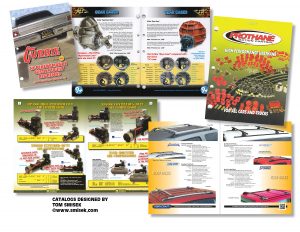
Whether you are selling, on-line, direct to end users, or through distributors and retailers, an impressive catalog is indispensable in presenting your products and making sales. A Good Catalog is not just a list of items, but a user-friendly organized classified directory. A Great Catalog is more than that! It is a compelling, well-designed buyers guide introducing new products and motivating shoppers to buy. There are five basic elements of catalog design, production and utilization: Design, Photos, Copy, Method of purchase and a Distribution campaign. Here is a look at each of these:
Catalog Design Catalogs all start out as a print layout, whether they are made available as downloadable PDF files, or integrated into a webpage. The catalog cover graphics should be distinctive, dynamic and represent the image of the marketer, as the cover sets the stage for what is to follow. The body of the catalog includes pagination of categories, sections and/or applications and should follow a prescribed sequence. Page uniformity of size, positioning and layout of photos, copy, specs and product info is important. This avoids a potpourri scrapbook look, of different sizes, shapes and backgrounds, in mix and match pages. Incorporating tabs, an index, contents or cross-reference sections can enhance usability and make it easier to navigate. Other enhancements include: Options and References, and “Also see…” mentions, along with Interactive Links that can be incorporated in product listings of on-line and PDF catalogs. These direct buyers to accessories, additional products and will boost sales.
Product Photography The quality of the photo depicts the quality of the product. A bad photo makes the product look less appealing and even inferior. Products should be shown, positioned as installed or in use, for easy buyer recognition. This is especially important when it comes to kits with multiple parts. A professional, photographer familiar with your product line, with computer enhancement elements, removes flaws and highlights features. In some cases, products in the R&D stage, not yet produced, can be generated utilizing skilled Photoshop techniques.
Product Copy is a combination of a heading, description, features and specifications. The information comes from the manufacturer, but needs to be written in a creative style. The heading identifies the product and may be the name, type of product, or a creative caption. This all depends on the type of catalog and the market it is directed to. Product copy should be descriptive of function, features and superior qualities, but not over-hype advertising. This text is best written as a third party objective overview. The specifications vary from simple to in-depth, depending on the product and market. Like the uniformity of the photos of the catalog page layout, the copy blocks should be similar in size, type style and format. The objective of product copy is to provide enough information to make a sale. Note: if the catalog is targeted at a senior market it is essential that the font be large for easy reading.
Method of Purchase Information is how the buyer is directed to take action. If it is a consumer catalog and the marketer is soliciting direct sales, pricing and how-to-order information needs to be integrated into the layout. If it is a trade catalog for dealers, distributors, jobbers and reps, merchandising materials and incentive programs may be included along with a separate confidential pricing sheet showing MSRP, and dealer costs breakdowns. A Sales Support Catalog is one that is distributed to consumers with “Where to buy” listings. It may be a Point-Of-Purchase collateral for dealers to provide to their customers and have an area for a dealer stamp or label.
The Distribution Campaign is the most important element in a coordinated catalog program. Getting printed catalogs out and promoting on-line downloads cannot be left up to chance, but requires a concerted effort. Printed catalogs can be mailed to existing and past customers, handed out at events, inserted in publications, mass-mailed, or otherwise distributed. New or updated catalogs can be advertised and announced through PR, email and direct mail. There are cost effective options to get collateral in front of perspective buyers, this can be implemented with a comprehensive marketing strategy.
Who does catalogs? Some marketers have relied on printers or graphic designers to produce their catalogs. While printers and freelancers may be good at their specialty, they do not have the comprehensive expertise to objectively develop collateral based on a marketing strategy. Printers are in business to sell printing and graphic artists do artwork. Both require the marketer to produce the information and direction of what goes into their catalog. Some businesses just copy their competitors catalog format, while others crank out the same catalog year after year. One of the biggest mistakes marketers make is to just change the catalog date and not the cover graphics. Recipients are unable to distinguish one from another. Reproducing the same format every year soon gets boring and the market becomes immune, and sales drop. Every catalog should have a distinctive, but familiar look. A fresh new look will boost sales. Another blunder is to cram new products wherever they will fit on the page. There are several creative methods professionals use to introduce new items that have been successful. Timing of the release of collateral is important and will impact response and sales. A marketing strategy will address this. All these factors need to be taken into consideration and are best handled working with a professional catalog specialist=
Professional Help is available. A Marketing Consultant with extensive experience in catalog development will work with your marketing/sales staff to design and produce effective collateral based on an objective marketing strategy. By providing all-inclusive catalog services to create, layout, photograph, write copy, coordinate the project and promotion, your GREAT Catalog will be a GREAT success. For more comprehensive information Contact Tom Smisek, Orange County Marketing Consultant: 714-649-2528
